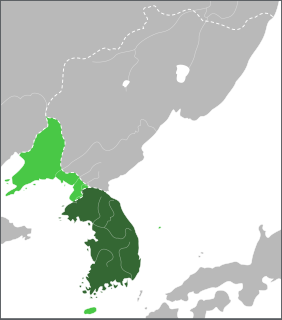
The concept of the Three Kingdoms of Korea (Hangul: 삼국시대) refers to the three kingdoms of Baekje (백제), Silla (신라) and Goguryeo (고구려). Goguryeo was later known as Goryeo (고려), from which the modern name Korea is derived. The Three Kingdoms period was defined as being from 57 BC to 668 AD.

North Jeolla Province or Jeollabuk-do is a province in the southwest of South Korea. The province was formed in 1896 from the northern half of the former Jeolla province, and remained a province of Korea until the country's division in 1945, then became part of South Korea. The provincial capital is Jeonju, which was the capital of all of Jeolla before 1896.

Bulguksa is located on the slopes of Mount Toham. It is a head temple of the Jogye Order of Korean Buddhism and encompasses seven National treasures of South Korea, including the Dabotap and Seokgatap stone pagodas, Cheongun-gyo, and two gilt-bronze statues of Buddha. The temple is classified as Historic and Scenic Site No. 1 by the South Korean government. In 1995, Bulguksa was added to the UNESCO World Heritage List together with the Seokguram Grotto, which lies four kilometers to the east.

Yeoju is a city in Gyeonggi Province, South Korea. Yeoju was a county but was raised to the status of a city in September 2013. Together with the neighboring city of Icheon, it is known as a major center of contemporary South Korean ceramics, and hosts the World Ceramic Exposition every year. Other local products of note include rice, sweet potatoes, and yellow melons. Yeoju is the birthplace of Korea's last queen, Empress Myeongseong.
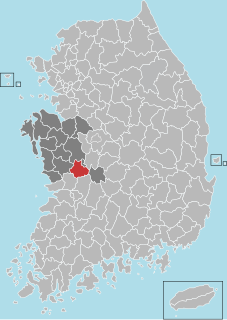
Nonsan is a city in South Chungcheong Province, South Korea. It is located at 36°12′N 127°5′E. Nonsan is also called Nolmoi, meaning dusk(y) or yellow mountain. The origin of Nonsan's geographical names is said to have come from the small garden " Nonmoi, " which rises in the middle of farming fields, where rice paddies and mountain are said to reflect geographical features.

A National Treasure is a tangible treasure, artifact, site, or building which is recognized by the South Korean government as having exceptional artistic, cultural and historical value to the country. The title is one of the eight State-designated heritage classifications assigned by the administrator of the Cultural Heritage Administration (CHA) in accordance with the Cultural Heritage Protection Act after deliberation by the Cultual Heritage Committee.

Mireuksa was the largest Buddhist temple in the ancient kingdom of Baekje in the Korean Peninsula. The temple was established in 602 by King Mu and is located 36.012083 N, 127.031028 E, modern Iksan, North Jeolla Province, South Korea. The site was excavated in 1980, disclosing many hitherto unknown facts about Baekje architecture. Mireuksaji Stone Pagoda is one of two extant Baekje pagodas. It is also the largest as well as being among the oldest of all Korean pagodas.
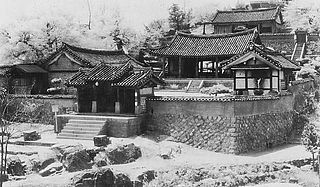
Korean architecture refers to an architectural style that developed over centuries in Korea.
Ever since the immigration of people originating from Siberia and Manchuria, Korea had kept an influence of Chinese architecture in the works because of close relations.
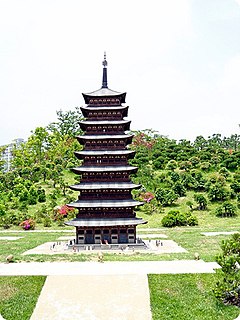
Hwangnyongsa, or Hwangnyong Temple is the name of a former Buddhist temple in the city of Gyeongju, South Korea. Completed in the 7th century, the enormous 9-story structure was built entirely with wood with interlocking design with no iron nails. It had a standing total height of 68 m or 80 m, making it the tallest structure in East Asia and the tallest wooden structure in the world at the time of its construction. It was the center of state-sponsored Buddhism during the Silla and Unified Silla eras which were cultural beacons of Buddhism during its time. Its name means "Golden/Yellow Dragon Temple" or "Emperor/Imperial Dragon Temple." Archaeological excavations and other scientific studies of the temple began in April 1976 and continue today.
The year 1917 in archaeology involved some significant events.

Sung Yu-ri is a South Korean actress and singer. She made her entertainment debut in 1998 as a member of the now-defunct K-pop group Fin.K.L. Sung turned to acting in 2002, starring in television dramas such as Thousand Years of Love (2003), The Snow Queen (2006), Hong Gil-dong (2008), and Feast of the Gods (2010).

Bunhwangsa is a temple complex from the Old Silla era of Korea. It is located in Gyeongju. The temple is recorded to have been built in 634 under the auspices of Queen Seondeok. Today the temple is still used by a small group of worshipers but in its heyday, the temple covered several acres and was one of the four main temples of the Silla Kingdom used by the state to ask the Buddha to bless the kingdom. The ruins of Hwangnyongsa Temple lay nearby. It is part of the UNESCO world heritage site Gyeongju Historic Areas.

Shilleuksa is a Korean Buddhist temple situated against a low hill on the north side of the river Namhan, three kilometers east of Yeoju in Gyeonggi Province, approximately one-hour southeast of Seoul. The only riverside temple in Korea, Shilleuksa is a sacred pilgrimage site and a repository of seven Treasures. A 500-year-old aromatic juniper tree and a 600-year-old ginkgo tree stand on the temple grounds.
Misari Regatta is a boat racing track and park located in the neighborhood of Misa-dong in Hanam City, Gyeonggi Province, in the vicinity of 20 km east of Seoul, South Korea. It was established for the rowing and canoeing competition during the 1986 Asian Games and the 1988 Olympics. The place has a 4.4 million square meters in total, the lake area of which covers 2,212 m in length, 140m in width and depth 3m. The area was originally a small island surrounded by sand which made its scenery as beautiful as if it were waving, so was named "Misa-ri" in Korean.

Oh Yeon-seo, is a South Korean actress and former member of South Korean girl group, LUV. She is best known for her roles in television dramas My Husband Got a Family (2012), Jang Bo-ri is Here! (2014), Shine or Go Crazy (2015), Please Come Back, Mister (2016), My Sassy Girl (2017), and A Korean Odyssey (2017–2018)
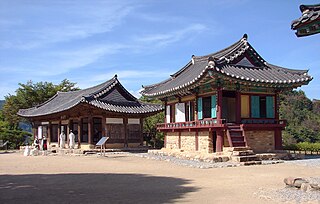
Cheongpung Cultural Properties Complex is a reconstruction of Cheongpung, a village that became submerged after the construction of Chungju Dam located on a ridge above Chungju Lake, south of Jecheon - North Chungcheong province South Korea. The SBS Jecheon setting is also co-located on the complex site.

Lee Hye-ri, better known mononymously as Hyeri, is a South Korean singer and actress. She is the youngest member of girl group Girl's Day and is known for her leading role in television drama Reply 1988 (2015). She ranked third in Forbes Korea Power Celebrity list in 2016.

The Baekje Historic Areas are a group of monuments located in three South Korean cities: Gongju, Buyeo, and Iksan. They relate to the last period of the Baekje Kingdom, representing the period from 475 to 660 CE, which was one of the three kingdoms that flourished from 18 BC to 660 AD. The property designated as a UNESCO World Heritage Site has eight archaeological sites. These are: The Gongsanseong fortress and the royal tombs at Songsan-ri, related to the capital city of Ungjin, now Gongju; the Busosanseong Fortress (부소산성) and Gwanbuk-ri administrative buildings, the Jeongnimsa Temple, the Neungsan-ri royal tombs, and the Naseong city wall in Sabi, now Buyeo; and the Wanggung-ri Palace and the Mireuksa Temple in Iksan, a subsidiary capital region of Sabi.

Iksan Mireuksaji Stone Pagoda is located in Mireuksaji, Geumma-myeon, Iksan-si, Jeollabuk-do, and is the oldest stone pagoda remaining in Korea and designated as the 11th national treasure.





